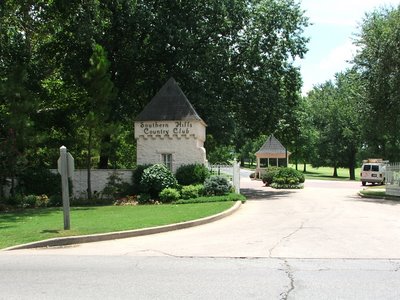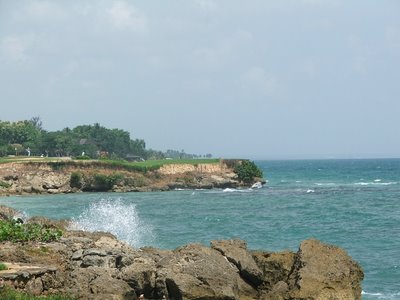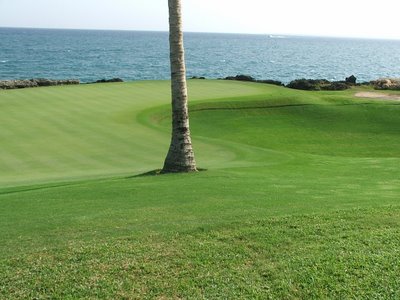
What do Prairie Dunes Country Club (ranked #23 in the world) and Southern Hills Country Club (ranked #41 in the world) have in common? Both were designed by Perry Maxwell during the depression era and both are located in the dust bowl region of the United States. Prairie Dunes in the flatlands of Kansas and Southern Hills in Tulsa Oklahoma. Maxwell must have been at the height of his creative genius in 1935, when both were built.
Perry Maxwell
Maxwell was a Princeton graduate and banker turned golf course architect. I had the opportunity to play both courses on a recent trip out West. I hadn't previously known who Perry Maxwell was. It turns out that not only did he design Prairie Dunes and Southern Hills but he also was called in to do green renovations at Pine Valley and Augusta National among other courses. For a time, he teamed up with Alister Mackenzie and worked on Crystal Downs (ranked #24 in the world). Not bad, for someone who is not generally well known in the world of golf course architecture. Maxwell's signature is his green design - generally small greens with severe undulations that are quite difficult.

The first green at Prairie Dunes
In Hutchinson, the premier hotel in town, The Grand Prairie, charges $69 per night including breakfast. Certainly, a true bargain on the quest to play the top 100. The hotel, which we were worried about, actually worked out fine. It was clean and we were able to have drinks with two members we didn't know who we met at the bar, who gave us some insight into the greatness of the course. They were so nice that one member actually drove back to his house and came back to give us a copy of the USGA Senior Open program that was recently held at Prairie Dunes so we could appreciate the holes. While the town was depressing, the golf course certainly was not.
The scorecard says the course is a Perry Maxwell Masterpiece and I would have to fully agree. Ben Crenshaw, the designer of Sand Hills has said of Prairie Dunes "this is golf on the first order." Jack Nicklaus called it the Pine Valley of the West. I was lucky to play Prairie Dunes on a nice day and with a two club wind, which is enough for you to get a good feel for how the course should play, without being overbearing. As compared to Southern Hills, the greens, while not large by conventional standards, are not quite as small. The greens almost all have at least two tiers so placement of your ball on the correct spot on the green is of paramount importance.
I can see the similarities in the two Perry Maxwell designs - lots of sharp doglegs and intelligent use of the terrain, particularly the uphill shots required into the greens. In almost no instance on the course is your shot to the green a level approach. Maxwell also took a minimalist approach to fairway bunkers which works out very well since the rough is quite penal and you don't need additional hazards. Joe Dye, former head of the U.S.G.A. once wrote that "a golf logo to symbolize the course would be a golfer standing deep in the rough looking for his ball." We hit into the rough a couple of times in our group and each time it was a lost ball.
The all-world 8th fairway at Prairie Dunes
Two holes in particular are truly world class - the 8th hole, which is the #1 handicap hole is a 430 yard dogleg right that plays uphill all the way. The feature that makes it unique are the massive ripples in the fairway that look like waves coming in from the ocean. You can see in the pictures above, with a golfer present for perspective, how severe the slope and rippling both are.
The 12th hole (pictured above) is a 390 yard par four and is also one of the best I've had the privilege to play. You hit your tee shot from an elevated tee to the fairway below. The strategy of the hole comes from two large cottonwood trees that are on either side of the fairway about 75 yards from the hole. These force you to either lay well back off the tee and then hit a high shot over them to the green or more typically to have to hit a low trajectory shot to a well protected and difficult green. It's too bad you don't see more holes like this. I guess this is because most golfers feel it is their right to have a clear shot at the green if they have a good drive in the fairway and architects generally agree. But I think this hole proves that there are exceptions (a very good exception in this case) to every rule. Also, in a stroke of brilliance, a really good drive hit precisely long enough and between the trees favoring the left side leaves an easy wedge shot between the trees. Great risk/reward!
I did some reading on Prairie Dunes prior to traveling to the course and was expecting the 10th hole to be a really exceptional hole. Maxwell himself said of the par three 10th hole - "this is the most beautiful par three ever constructed. Cypress Point, St. Andrews, Pinehurst and Augusta have nothing to compare with it." I don't agree with Mr. Maxwell on this point. The 10th is a fine golf hole but I actually thought that the 2nd (pictured below) and 4th hole, also par threes, were as good or better.

In an unfortunate incident at Prairie Dunes, on the 9th green the threesome riding behind us hit up on us while our threesome was on the green. Not just one golfer - all three players. For my regular readers you will know that I play fast - in fact we were playing at a good clip and most of the time were waiting for a twosome in front of us to move before we could hit. Being guests to the club we didn't make a big deal out of it. We let the assholes play through on the 10th tee. I'm not sure whether the three were just angry at living in a two-prison town or whether they had too much to drink, but this kind of behavior is not acceptable. God forbid they hit someone in the eye or the head with the ball - hitting up on people is a very bad idea. We mentioned the incident to the cart girl who was roaming the course with beverages. She said that this particular group has a reputation for hitting up on people while drinking. This is a commercial for not having a beverage cart circulate on a golf course, especially since this course had water on almost every tee box anyway. I'm sure most of the members of Prairie Dunes are delightful people but they should not tolerate this type of bad behavior. The cart girl apologized to us as did the assistant-pro whom she told as well. I don't see a place in golf for morons like these, though. If you would like to play through, all you have to do is ask. I hope the course has a good liability insurance policy in place while these guys remain members. Oh, and in what I think is complete poetic justice, to just prove the lack of intelligence of these fools, one drove out of the course after the round in a Hummer. In any event, I don't want to end on a negative, the place is great.
Kudos to the superintendents and green staff at both courses, which were in great condition. Prairie Dunes is a private club and access to play the course is through a member. You can visit their website for more history. The same for Southern Hills which will play host to the 2007 PGA Championship.








